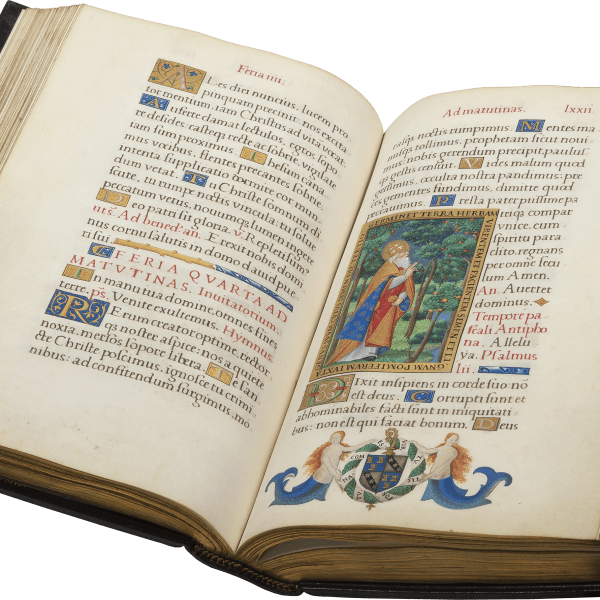Les Enluminures A Beginner's Guide To Medieval Manuscripts
ABC, Glossary on Medieval Manuscripts
Illuminated manuscripts are books that have been written and decorated by hand in the Middle Ages and the Renaissance (manum=hand; scriptum=written). Before Gutenberg invented printing around 1450, all books were entirely handmade, and even after the beginning of printing, the manuscript persisted in popularity. Manuscripts were written and painted on parchment (vellum) made from the skins of different animals. Cows, sheep, goats, squirrels, and possibly even cats, were used to make parchment. The color and texture of parchment vary according to the type of animal used, the method of preparing the skins, and perhaps even the place where the animal was raised and what it ate.
The beautiful, handwritten texts were created by scribes, who learned to write in many different types of script. One Irish monk complained of his task in the margins of a manuscript: "Thin ink, bad vellum, difficult text."
The adornment of the book, or illumination, depended on the skill of the illuminator and the wealth of the person who commissioned the book. Before the thirteenth century, manuscripts were made mostly in monasteries, the monks toiling away by candlelight for the love of God not money. From at least the thirteenth century, however, medieval illuminators were lay craftsmen, members of the Guild of Saint Luke, who lived and worked in urban centers. Illumination actually refers to the art of decorating books with bright colors and precious metals so that they sparkle or "light up." Individual pages could receive such illumination as: decorated initials, borders, line endings drolleries (human or animal images in the borders of a page, often fantastical) and miniatures (the paintings, derived from the Latin word minium, meaning red pigment). The artist worked with natural substances, such as saffron, brazil wood, azurite, malachite, and dragonsblood. Precious metals and gems, such as gold, silver, and lapis lazuli, were also used. Gold was applied to the page in two ways, either burnished (the shiny form of gold, polished with an animal tooth) or liquid (applied as paint in suspension).
There are manuscripts of many different types of texts. Among religious texts the most common are Bibles, Breviaries and Missals, and Choir Books. Not all manuscripts in the Middle Ages were religious, however. There are romances, chronicles, poetry, as well as books on cooking, hunting, medicine, agriculture, and so forth. The Book of Hours falls in a category all by itself. Although Latin was the universal language in Europe in the Middle Ages, the growth of the vernacular in different regions meant that especially secular books used in everyday life were often composed in the language of the people, for example, in French, Spanish, Italian, German, Dutch, and English. For examples of manuscripts on diverse subjects interesting for their texts see www.textmanuscripts.com maintained by Les Enluminures.
Further Reading:
Michelle Brown, Understanding Illuminated Manuscripts. A Guide to Technical Terms, The J. Paul Getty Museum and the British Library, 1995.
Online Encyclopedia articles on Medieval and Renaissance Book Production (The Manuscript Book and The Printed Book)
http://the-orb.net/encyclop/culture/books/medbook1.html
Online Medieval Manuscript Manual, created by the Department of Medieval Studies at Central European University, Budapest.
http://www.ceu.hu/medstud/manual/MMM/
Online Art History Resources-Manuscripts (with numerous links) http://witcombe.sbc.edu/ARTHmedieval.html
